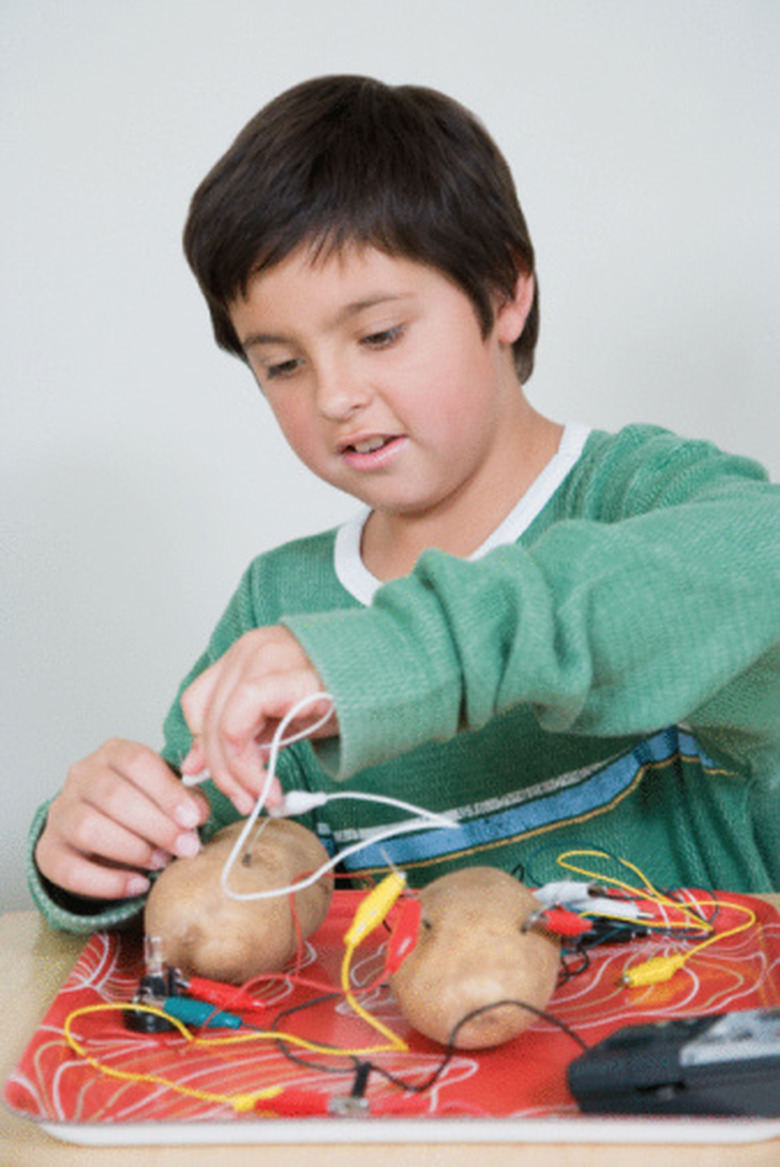Polarity Projects Using A Potato
Polarity projects that involve potatoes enable students to experiment with electrolysis or the transmission of an electric charge through conducting liquids to cause chemical changes. These conducting liquids are known as electrolytes. Students can also conduct simple tests on polarity, or how electrons flow from a negative to a positive pole, by using copper wires, batteries and potatoes. They can progress to creating potato batteries that power electrical devices.
Easiest: Test Polarity
Easiest: Test Polarity
Gather two, 6-inch-long plastic-insulated copper wires, a D-cell battery, a potato, tape, a knife and pair of scissors. Use the scissors to strip about 1 1/2 inches of insulation from the wire ends. Position the battery on its side. Tape one wire to the battery's positive side and the second wire to the battery's negative side, which is flat. Slice the potato in half. Insert the stripped ends of the copper wires into the potato's flesh at a depth of at least three inches. Observe how the electrons that flow out of the battery's negative side and through the wire into the potato turns the potato green. Watch for bubbles that form in the potato next to the wire end attached to the battery's positive side. Consider how the potato acts as an electrolyte, which conducts an electrical current between positive and negative polarities.
Easy: Measure Voltage
Easy: Measure Voltage
Gather a potato, a voltmeter, sandpaper, a large galvanized nail and a two-inch, 12- or 14-gauge piece of copper wire. Scrape the wire and nail with the sandpaper until they shine. Insert the nail and wire about an inch into the potato, positioning them an inch apart. Set the voltmeter to the lowest DC voltage. Insert the red lead into the positive voltage slot and the black lead into the negative slot. With the voltmeter turned on, use the red lead to touch the copper wire and the black lead to touch the nail. Record the amount of voltage that the potato produced from the voltmeter reading.
Moderate: Make a Battery
Moderate: Make a Battery
Gather two pieces of heavy copper wire, two galvanized nails, two potatoes, three alligator clips connected to each other with wire and a low-voltage LED clock. Take the battery out of the clock, noting the positions of the battery's positive and negative ends in the compartment. Label the potatoes as "A" and "B." Insert a nail and copper wire into each potato, positioning them as far apart as possible. Connect the copper wire in potato A to the positive terminal in the clock's battery compartment with an alligator clip. Connect the nail in potato B to the compartment's negative terminal with an alligator clip. Connect the nail in potato A to the wire in potato B with the third alligator clip. Observe the clock turn on and set the time. Consider how the potato's chemical energy is transformed into electrical energy as the zinc ions from the nail react with copper ions from the wire, resulting in a flow of electrons through the copper wire and into the clock.
Challenging: Calculate Voltage to Power Different Objects
Challenging: Calculate Voltage to Power Different Objects
Use a multimeter that measures voltage, current and resistance of the circuit produced by the potato battery in the above experiment to estimate how many potatoes would be required to power different objects. If one potato produces 0.8 volts, how many potatoes will you need to add to the series to light a 1.5 volt bulb? How many potatoes are required to turn on a 5-volt digital clock? Experiment with the difference between current and voltage and the size and number of potatoes used to make the battery. Note how the size of the current depends on the size of the individual potato while the amount of voltage relates to the number of potatoes used to create the series.
Cite This Article
MLA
Tang, Kay. "Polarity Projects Using A Potato" sciencing.com, https://www.sciencing.com/polarity-projects-using-potato-8700695/. 24 April 2017.
APA
Tang, Kay. (2017, April 24). Polarity Projects Using A Potato. sciencing.com. Retrieved from https://www.sciencing.com/polarity-projects-using-potato-8700695/
Chicago
Tang, Kay. Polarity Projects Using A Potato last modified March 24, 2022. https://www.sciencing.com/polarity-projects-using-potato-8700695/
